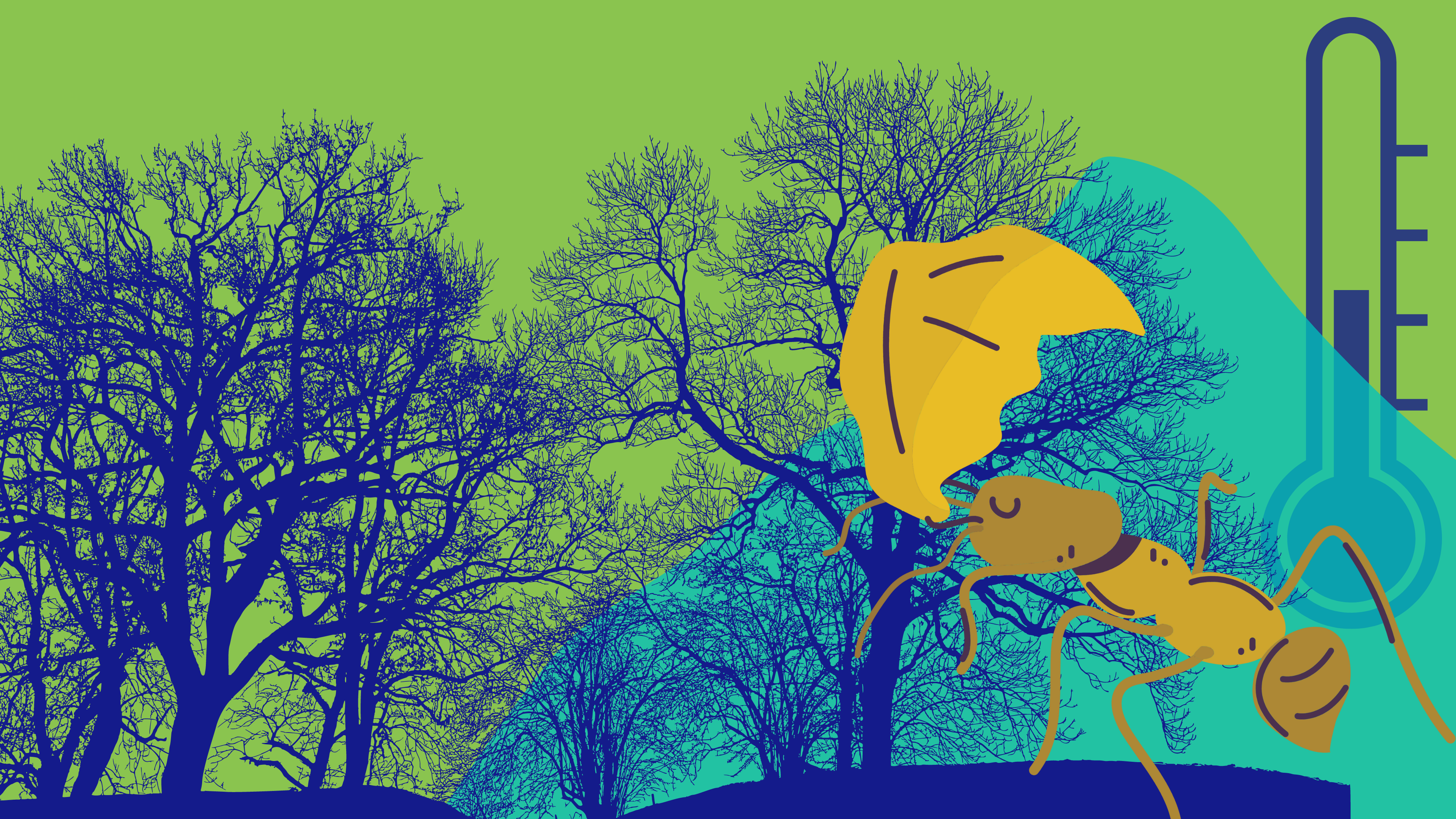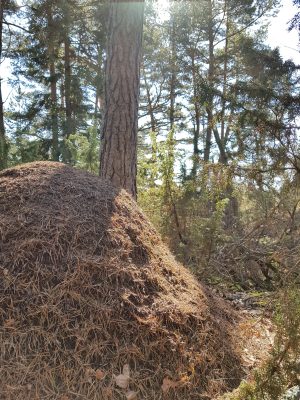
Are hybrid ants the answer to adaptation to climate change?
beatriz portinha is a PhD student at the University of Helsinki, Finland, and at the University of Lisbon, Portugal. she is currently studying populations of hybrid mound building wood ants.
This article is part of the anthropocene theme.
edited by Kenia, Reviewed and illustration by usha, narrated by nelly.
If you venture into the woods in Southern Finland, around the Hanko area, you’ll find groups of mounds with hundreds of ants dwelling on top that will spit acid at you when provoked. While the ants themselves are small and easy to miss, the mounds they build can be as tall as a person, making them impressive and eye-catching. While you may be used to ants in your everyday life, these aren’t any ordinary ants; these particular ants are hybrids between two different species, Formica polyctena and Formica aquilonia. What makes these hybrid ants extraordinary, you may ask? Worry not, we will get there. But first, let me explain what hybridization means and why it is so relevant in today’s world.
It is said that we now live in the Anthropocene, a geological epoch characterized by intense man-made climate change. In a nutshell, our climate seems to be shifting much faster than the normal rate of change most species are capable of, posing an overwhelming challenge to the preservation of biodiversity on the planet. In this context, hybridization, the combination of genetic material from species that are adapted to different environments, has come to be viewed as a promising avenue for faster adaptation to climate change in recent years. For example, our main characters, the ants in Southern Finland, are hybrids between a warm-adapted and a cold-adapted species. Can we, by studying them, find an answer to how hybridization can facilitate fast adaptation to man-made climate change?
The SpecIAnt (Speciation in Ants) research group, based at the University of Helsinki, Finland, has studied speciation and hybridization in mound-building red wood ants for over ten years, with a particular focus on these hybrid ants. I started working in this group in 2019 during my MSc thesis, where I reconstructed the speciation and hybridization history between F. polyctena and F. aquilonia, our protagonist species. These ants are especially interesting because they are a keystone species in Finnish forests (meaning that other species in the forest habitat depend on the ants for their survival). Recent work by previous group members, master students Raphael and Elisa, showed that the parental species of the hybrids are divergently (a fancy word for differently) adapted to temperature: F. polyctena does well in warm temperatures and poorly in cold temperatures, while F. aquilonia does well in cold temperatures and poorly in warm temperatures. Raphael and Elisa tested how well the hybrid ants do in both temperatures and found that the hybrids are equally resistant to heat as their F. polyctena parentals, but they are not as resistant to cold as their F. aquilonia parentals. Thus, the union of F. polyctena and F. aquilonia genes produced a new single entity, i.e., the hybrid ants, with exciting adaptive potential focused on the present climate change context characterized by a warming climate.

Further, and even more exciting, Raphael and Elisa also found that the hybrid ants can respond to quick changes in their surrounding environmental temperature on a time scale as small as a year. In colder years, genes from F. aquilonia, the cold-adapted parental species, are more abundant in the hybrid populations. In warmer years, we see genes from F. polyctena, the warm-adapted parental species, become more frequent. This shows that these ants respond quickly to fluctuations in the climate, highlighting their potential to adapt quickly to future environmental changes as a direct result of their hybrid origin. This constitutes adaptive introgression by way of hybridization. Introgression is what happens when two different species reproduce with each other, and genes move from one species to another. Introgression is adaptive when the genes that come from one of the species are advantageous to the individuals of the other species, helping them adapt to the demands of their environment. What is remarkable about the hybrid ants in this story is that they combine genes with adaptive value of their two parental species in a single organism.
With man-made climate change and habitat disruption progressively increasing in the Anthropocene, there are other documented examples of adaptive introgression between species, both in plants and animals. For example, over multiple European lakes, hybrids between three Daphnia species, small crustaceans, are dominant in lakes with higher trophic states (i.e., the biological condition of a lake). These higher trophic states are caused by man-made eutrophication, which is the saturation of water bodies with fertilizer run-off, such as phosphorus and nitrogen. In Texas, USA, two species of weedy sunflowers are known to have hybridized and formed a stable hybrid subspecies. The hybrid sunflowers are more similar to one of their parental species, which is more resistant to herbivore consumption. Consequently, they have higher reproductive success and sunflowers are better adapted to the environment compared to their other parental species. In an experimental setting, the hybrid sunflowers also adapt more quickly to the same environmental conditions than one of the parental species, highlighting, once again, the potential of hybrids to respond and adapt quickly. In my Ph.D., starting this Fall, I will study how the hybrid ant populations in Southern Finland respond to different pressures. I will use both simulations and experimental work to try to provide knowledge on the interplay of different processes acting on young hybrid populations.
Given its potential to provide a faster route for adaptation to fast changing environments, hybridization is predicted to increase as the climate warms. Outside very specific academic fields, and save for the bug aficionados, ants are commonly seen simply as troublesome household pests. To you, ants may have been just the interesting little animals walking in a neat line at the park, carrying crumbs of food or the occasional leaf. I hope this article changed your mind. I hope you now see the relevance that even the small things can have and the importance of continuous research that is not always straightforward. The findings of this research, using hybrid ants, can be applied to a variety of species in the coming years, even to ours. And these tiny animals are just one source of wonder and discovery surrounding us. Who knows what else is out there waiting for us to take a peek and discover a new perspective?
REFERENCES
Chunco, A. J. (2014). Hybridization in a warmer world. Ecology and Evolution, 4(10), 2019–2031.
Keller, B., Wolinska, J., Manca, M. & Spaak, P. (2008). Spatial, environmental and anthropogenic effects on the taxon composition of hybridizing Daphnia. Philosophical Transactions of the Royal Society B: Biological Sciences, 363(1505), 2943–2952.
Martin-Roy, R., Nygård, E., Nouhaud, P. & Kulmuni, J. (2021). Differences in thermal tolerance between parental species could fuel thermal adaptation in hybrid wood ants. American Naturalist, 198(2), 278-294.
Mitchell, N., Owens, G. L., Hovick, S. M., Rieseberg, L. H. & Whitney, K. D. (2019). Hybridization speeds adaptive evolution in an eight-year field experiment. Scientific Reports, 9(1), 1–12.
Nouhaud, P., Martin, S. H., Portinha, B., Sousa, V. C. & Kulmuni, J. (2022). Rapid and repeatable genome evolution across three hybrid ant populations. bioRxiv.
Phadnis, N., Baker, E. P., Cooper, J. C., Frizzell, K. A., Hsieh, E., De La Cruz, A. F. A., Shendure, J., Kitzman, J. O. & Malik H. S. (2015). An essential cell cycle regulation gene causes hybrid inviability in Drosophila. Science, 350(6267), 1552–1555.
Portinha, B., Avril, A., Bernasconi, C., Helanterä, H., Monaghan, J., Seifert, B., Sousa, V. C., Kulmuni, J. & Nouhaud, P. (2022). Whole-genome analysis of multiple wood ant population pairs supports similar speciation histories, but different degrees of gene flow, across their European ranges. Molecular Ecology.
Schwenk, K., Brede, N., & Streit, B. (2008). Introduction. Extent, processes and evolutionary impact of interspecific hybridization in animals. Philosophical Transactions of the Royal Society B: Biological Sciences, 363(1505), 2805–2811.
Whitney, K. D., Randell, R. A., & Rieseberg, L. H. (2006). Adaptive introgression of herbivore resistance traits in the weedy sunflower Helianthus annuus. American Naturalist, 167(6), 794–807.
Whitney, K. D., Randell, R. A., & Rieseberg, L. H. (2010). Adaptive introgression of abiotic tolerance traits in the sunflower Helianthus annuus. New Phytologist, 187(1), 230–239.